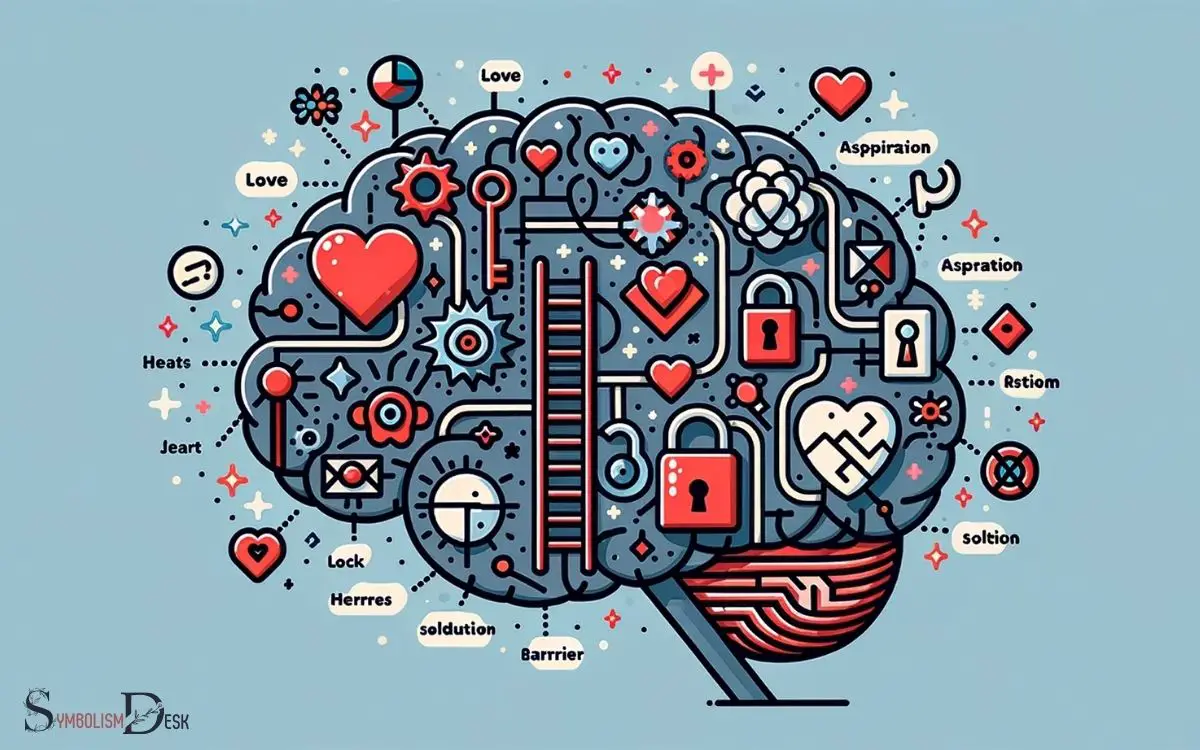What Does Symbolic Meaning Mean? Objects!
Symbolic meaning refers to the significance or deeper interpretation assigned to objects, figures, or colors that transcend their literal existence.
For example, a red rose commonly symbolizes love and passion. Understanding symbolic meanings is essential for comprehending various cultural expressions and communications.
Symbolic meanings are crucial in conveying abstract concepts and emotions that cannot be easily articulated.
They are:
- Historically rooted: Many symbols have origins in ancient cultures and have been passed down through generations.
- Psychologically impactful: Symbols can evoke emotional responses or convey complex psychological states.
- Culturally significant: Different cultures have unique symbols that reflect their values and beliefs.
- Expressive in language and art: Symbolism is a powerful tool in literature, visual arts, and everyday language to suggest ideas and invoke thought.
For example, a dove often symbolizes peace, while a snake may represent danger or deceit.
The language of symbols enriches our communication, enabling us to share and understand profound human experiences across various mediums.

Key Takeaway
Understanding the Symbolic Meanings: An Overview
| Term | Definition | Example |
|---|---|---|
| Symbolic Meaning | The meaning or idea attributed to a symbol, object, or action that goes beyond its literal definition or purpose | A dove representing peace |
| Symbol | An object, sign, or image that represents an idea, concept, or message through its form, shape, or appearance | The peace symbol ☮ |
| Metaphor | A figure of speech that compares two seemingly unrelated subjects to help convey a deeper meaning | “Her heart is a fortress”, where the heart represents emotions, and the fortress symbolizes protection |
| Allegory | An extended metaphor or narrative where characters, objects, and actions represent broader ideas or messages | George Orwell’s “Animal Farm”, where animals represent the political landscape of the time |
| Iconography | The study and interpretation of symbols, themes, and subject matter in visual arts, often used to understand the symbolic meaning within the artwork | The interpretation of color symbolism in Vincent van Gogh’s “Starry Night” |
| Semiotics | The study of signs, symbols, and communication within and between cultures, including the interpretation of meaning from signs and symbols | Decoding the meaning of emojis in digital communication |
| Archetype | A symbol, theme, or character type that recurs across cultures and literature, representing universal meanings or patterns | The “hero” archetype appearing in stories across cultures |
What Does the Word Symbolic Mean
The word “symbolic” is an adjective that relates to symbols or symbolism. Symbols are objects, actions, or concepts that represent something else beyond their literal meaning. In literature and art, symbolic elements are often used to convey deeper meanings or emotions. For example, in many cultures, different fruits are imbued with diverse fruit symbolism explained through traditions, rituals, and folklore. Understanding the symbolic meaning behind these fruits can provide insight into the values and beliefs of a particular society. Additionally, the use of symbolic language in communication and storytelling can add layers of complexity and richness to the message being conveyed.
When something is described as “symbolic,” it means that it is associated with or represents something abstract, often carrying deeper or hidden meanings or connotations.
For example, if a person gives a red rose as a gift on Valentine’s Day, the red rose is symbolic of love and affection. In this context, the act of giving a red rose is symbolic of expressing love and romantic feelings.
In a broader sense, “symbolic” can refer to anything that has a symbolic or metaphorical significance, conveying meaning beyond its surface appearance. It can also refer to actions or gestures that are intended to convey a message or convey a particular meaning indirectly.
The Nature of Symbolic Meaning
Understanding the nature of symbolic meaning involves examining the ways in which symbols convey abstract concepts and represent deeper layers of meaning.
Symbols are vehicles for communicating ideas, beliefs, and cultural values, often transcending language barriers. They can evoke emotions, trigger memories, or encapsulate complex ideologies within a single image.
The power of symbols lies in their ability to condense profound meanings into a concise form, allowing for universal interpretation while retaining individual subjectivity.
Whether through religious icons, national flags, or corporate logos, symbols permeate every facet of human existence, shaping perceptions and influencing behaviors.
Moreover, symbols possess the capacity to evolve and accrue new meanings over time, adapting to societal shifts and reflecting contemporary paradigms. Thus, comprehending the nature of symbolic meaning unveils the intricate web of human communication and cognition.
Historical Perspectives on Symbolism
Throughout history, the use of symbolism has played a significant role in shaping cultural and societal narratives. Symbolism has been integral to human communication and expression since ancient times.
In the ancient world, symbols were used to convey spiritual beliefs, cultural values, and political power. For example, the Egyptian ankh symbolized life and immortality, while the Christian fish symbol represented faith and salvation.
In the medieval period, heraldic symbols conveyed lineage and status. During the Renaissance, artists used symbolism to convey complex allegorical meanings in their works.
In the 19th and 20th centuries, symbolism became a cornerstone of literary and artistic movements, such as Symbolism and Surrealism.
Understanding historical perspectives on symbolism provides insight into how symbols have shaped human thought and expression across different eras and cultures.
Psychological Significance of Symbols
The psychological significance of symbols holds a crucial place in understanding human behavior and cognition.
Symbols in psychology serve as a means of expressing complex emotions and subconscious thoughts.
Symbolic Meaning in Psychology
When exploring the field of psychology, it is essential to recognize the profound impact of symbolic meaning and the psychological significance of symbols.
In the realm of psychology, symbols hold a crucial role in understanding human behavior, thoughts, and emotions.
Symbolic meaning in psychology refers to the interpretation and analysis of symbols in relation to the human mind and behavior.
Symbols often represent unconscious thoughts and feelings, providing a pathway for individuals to express and understand their innermost emotions.
These symbols can manifest in dreams, art, language, and rituals, offering psychologists valuable insights into the human psyche.
Understanding Hidden Symbolism
With regard to the psychological significance of symbols, delving into the understanding of hidden symbolism is crucial for comprehending the intricate workings of the human mind.
Symbols carry hidden meanings that can evoke powerful emotions and tap into the subconscious.
Here is a table that illustrates the psychological significance of some common symbols:
| Symbol | Psychological Significance | Example |
|---|---|---|
| Butterfly | Transformation, growth | Emerging from a cocoon |
| Dove | Peace, purity | Carrying an olive branch |
| Snake | Rebirth, healing | Shedding its skin |
| Rose | Love, beauty | Blooming in adversity |
Understanding these hidden symbols can provide insight into our deepest thoughts, feelings, and desires, offering a richer understanding of ourselves and the world around us.
Impact on Human Behavior
Symbols wield significant influence on human behavior due to their psychological significance, prompting profound emotional and cognitive responses. The impact of symbols on human behavior is profound, shaping perceptions, attitudes, and actions in various ways.
This psychological significance of symbols can lead to:
- Emotional Triggers: Symbols can evoke strong emotional responses, influencing mood and behavior.
- Cognitive Associations: Symbols are linked to specific meanings, shaping thought processes and decision-making.
- Behavioral Conditioning: Symbols can influence behavior through repeated exposure and reinforcement.
Understanding the psychological significance of symbols is crucial for comprehending their impact on human behavior, as they play a pivotal role in shaping individual and collective actions, beliefs, and societal norms.
Cultural and Societal Symbolism
The symbolic meanings embedded in cultural practices and societal structures have a profound impact on our understanding of the world around us.
Cultural symbolism shapes our values, beliefs, and traditions, while societal symbolism holds significant influence over our social interactions and institutions.
Recognizing the presence of symbolism in everyday life allows us to better comprehend the complexities of our cultural and societal environments.
Cultural Symbolism’s Impact
Cultural symbolism profoundly influences the values, beliefs, and behaviors of societies and individuals. It plays a pivotal role in shaping the identity and collective consciousness of a community, impacting various aspects of life.
Consider the following:
- Language: Cultural symbols often manifest in language, influencing communication patterns and shaping the worldview of a society.
- Traditions and Rituals: Symbolic meanings embedded in traditions and rituals contribute to the preservation of cultural heritage and the reinforcement of societal norms.
- Art and Literature: Cultural symbolism is intricately woven into artistic expressions and literature, serving as a reflection of societal values and ideologies.
Understanding the impact of cultural symbolism is crucial in comprehending the complexities of human societies. This awareness sets the stage for exploring the significance of societal symbolism in shaping collective behaviors and perceptions.
Societal Symbolism’s Significance
Expanding upon the significance of societal symbolism necessitates a comprehensive analysis of its multifaceted influence on collective behaviors and perceptions.
Societal symbolism encompasses the values, beliefs, and norms that a society collectively holds, often represented through rituals, traditions, and cultural artifacts.
These symbols play a crucial role in shaping the identity of a community, fostering a sense of belonging, and providing a framework for understanding the world.
Moreover, societal symbolism serves as a means of communication, conveying complex ideas and emotions in a manner that transcends language barriers. It fosters a shared understanding and solidarity among individuals within a society.
Symbolism in Everyday Life
Understanding the pervasive influence of cultural and societal symbolism in everyday life is essential for comprehending the intricacies of human behavior and social interactions.
Symbolism permeates various aspects of our daily lives, shaping our thoughts, beliefs, and actions in profound ways.
Cultural and societal symbolism manifests in numerous forms, including:
Rituals and Traditions: Many cultural symbols are embedded within rituals and traditions, often passed down through generations.
Language and Communication: Symbols are woven into language, gestures, and expressions, influencing how individuals communicate and interpret messages.
Art and Media: Symbolism is prevalent in art, literature, and media, conveying deeper meanings and evoking emotional responses.
Acknowledging the prevalence of symbolism in everyday life enhances our understanding of diverse cultural perspectives and societal dynamics.
Symbolism in Language and Art
The symbolic meaning in language and art plays a crucial role in communicating abstract concepts and conveying deeper layers of meaning.
In language, symbolism is evident in metaphors, allegories, and idioms, where words or phrases carry symbolic significance beyond their literal interpretation.
This allows for the expression of complex emotions, ideas, and philosophies that may be challenging to articulate directly.
Similarly, art utilizes symbols to evoke emotions, provoke thoughts, and create connections between the artist and the audience. Whether through colors, shapes, or objects, artists imbue their work with symbolic meaning, inviting viewers to interpret and engage with the art on a profound level.
Understanding symbolism in language and art enriches communication and fosters a deeper appreciation for the intricacies of human expression.
What Is the Symbolic Meaning Behind Other Objects?
The symbolic meaning of cascarones is rooted in Mexican tradition. These colorful, confetti-filled eggs are often seen as symbols of good luck and are cracked over the heads of friends and family during celebrations. They represent joy, unity, and the sharing of positive energy among loved ones.
Practical Applications of Symbolic Meaning
One practical application of symbolic meaning is its use in marketing to convey subtle messages and evoke specific emotions in consumers.
Marketers strategically employ symbolism to create a deeper connection with their target audience, influencing perceptions and attitudes towards products or brands.
This can be achieved through:
- Logo Design: Companies use symbols and imagery in their logos to communicate their values and establish brand identity.
- Color Psychology: The choice of colors in branding and advertising can symbolize different emotions and associations, influencing consumer behavior.
- Packaging Symbolism: Symbols and visuals on product packaging can convey messages about quality, sustainability, or cultural relevance, impacting consumer purchasing decisions.
Conclusion
In conclusion, the concept of symbolic meaning encompasses a wide range of perspectives, from historical and psychological to cultural and artistic.
Symbols hold significant importance in various aspects of human life and can be interpreted in different ways.
Understanding symbolic meaning can provide valuable insights into the human experience and offer practical applications in fields such as psychology, art, and language.
Further exploration of symbolic meaning can deepen our understanding of human behavior and societal dynamics.






